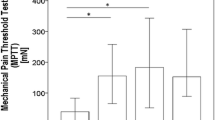Abstract
Injection site pain (ISP) reduces compliance of botulinum toxin (BT) therapy considerably. We wanted to study whether nitrous oxide/oxygen (NOO, Livopan®, Linde Gas Therapeutics, Unterschleißheim, Germany) can reduce ISP in patients receiving intracutaneous BT injections for axillary or palmar hyperhidrosis (HH). The study followed an open-label design comparing intraindividually ISP in both axillae and/or both palms when NOO was applied or not during BT injections. BT efficacy was measured by the Hyperhidrosis Disease Severity Scale (HDSS) and by a 4-point Self-Assessment Scale. ISP was documented by a Visual Analogue Scale (VAS) and the Verbal Scale of Pain Intensity (VSPI), adverse effects by a Structuralised Interview (SI). Altogether 13 patients (age 34.1 ± 12.4 years, 9 females, 4 males) were studied. 11 BT treatments were for biaxillary and 3 for bipalmar HH. BT reduced biaxillary HH from HDSS 3.7 ± 0.5 to 1.0 ± 0 and bipalmar HH from 3.6 ± 0.6 to 1.0 ± 0. All patients reported ISP reduction by NOO. In axillary HH, NOO reduced ISP from 55.7 ± 12.7 to 12.8 ± 7.5 on the VAS (p < 0.05) and from 4.1 ± 0.3 to 0.7 ± 0.5 on the VSPI (p < 0.05), in bipalmar HH from 60.0 ± 10.0 to 13.3 ± 5.8 on the VAS (p < 0.05) and from 5.0 ± 0 to 1.3 ± 0.5 on the VSPI (p < 0.05). Adverse effects were not identified. NOO is a potent, non-sedative, quickly reversible and safe inhalative analgesic which reduces ISP considerably in patients receiving BT therapy for axillary and palmar HH thus substantially improving compliance of BT therapy.


Similar content being viewed by others
Abbreviations
- BT:
-
Botulinum toxin
- NOO:
-
Nitrous oxide/oxygen
- ISP:
-
Injection site pain
- HDSS:
-
Hyperhidrosis Disease Severity Scale
- VAS:
-
Visual Analogue Scale
- VSPI:
-
Verbal Scale of Pain Intensity
- SAS:
-
Self-Assessment Scale
- SI:
-
Structuralised Interview
References
Campanati A, Lagalla G, Penna L, Gesuita R, Offidani A (2004) Local neural block at the wrist for treatment of palmar hyperhidrosis with botulinum toxin: technical improvements. J Am Acad Dermatol 5:345–348
Collado V, Nicolas E, Faulks D, Hannequin M (2007) A review of the safety of 50 % nitrous oxide/oxygen in conscious sedation. Expert Opin Drug Saf 6:559–571
D’Arcy Y (2003) Pain assessment, Chapter 2. In: Iyer P (ed) Medical-Legal Aspects of Pain and Suffering. Lawyers and Judges Publishing Company, Tucson, AZ
Kontochristopoulous G, Gregoriou S, Zakopolou N, Rigopoulos D (2006) Cryoanalgesia with dichlorotetrafluroethane spray versus ice packs in patients treated with botulinum toxin-a for palmar hyperhidrosis: self-controlled study. Dermatol Surg 32:31–33
Kouris A, Armyra K, Christodoulou C, Karimali P, Karypidis D, Kontochristopoulous G (2014) Quality of life in patients with focal hyperhidrosis before and after treatment with botulinum toxin A. ISRN Dermatol 2014:ID 308650
Lowe N, Campanati A, Bodokh I, Cliff S, Jaen P, Kreyden O, Naumann M, Offidani A, Vadoud J, Hamm H (2004) The place of botulinum toxin type A in the treatment of focal hyperhidrosis. Br J Dermatol 151:1115–1122
Naumann M (2001) Evidence based medicine: botulinum toxin in focal hyperhidrosis. J Neurol 248:31–33
Solish N, Bertucci V, Dansereau A, Hong HC, Lynde C, Lupin M, Smith KC, Storwick G, Canadian Hyperhidrosis Advisory Committee (2007) A comprehensive approach to the recognition, diagnosis, and severity-based treatment of focal hyperhidrosis: recommendations of the Canadian Hyperhidrosis Advisory Committee. Dermatol Surg 33:908–923
Strutton DR, Kowalski JW, Glaser DA, Stang PE (2004) US prevalence of hyperhidrosis and impact on individuals with axillary hyperhidrosis: results from a national survey. J Am Acad Dermatol 51:241–248
Author information
Authors and Affiliations
Corresponding author
Rights and permissions
About this article
Cite this article
Paracka, L., Kollewe, K., Dengler, R. et al. Botulinum toxin therapy for hyperhidrosis: reduction of injection site pain by nitrous oxide/oxygen mixtures. J Neural Transm 122, 1279–1282 (2015). https://doi.org/10.1007/s00702-015-1372-x
Received:
Accepted:
Published:
Issue Date:
DOI: https://doi.org/10.1007/s00702-015-1372-x




